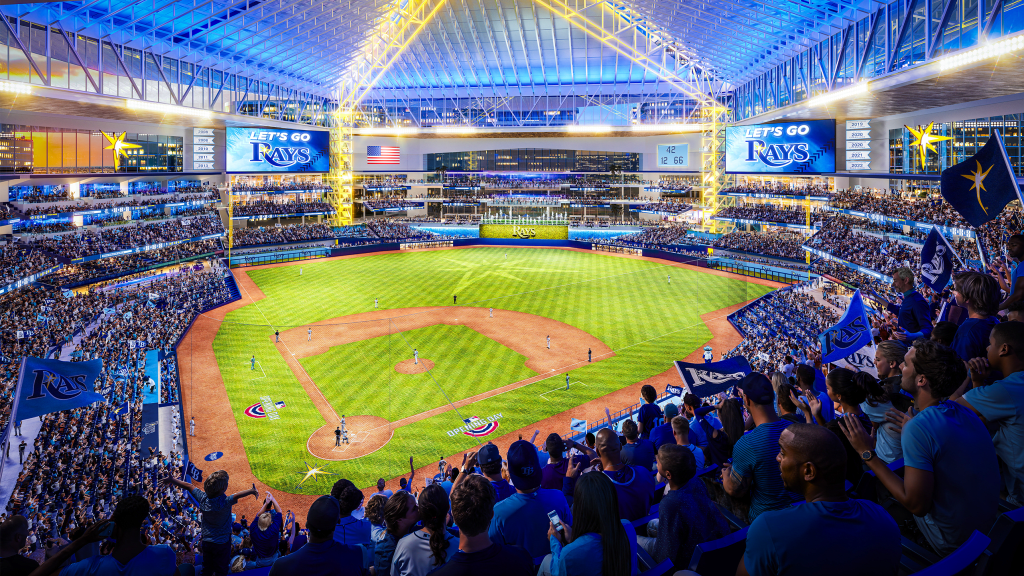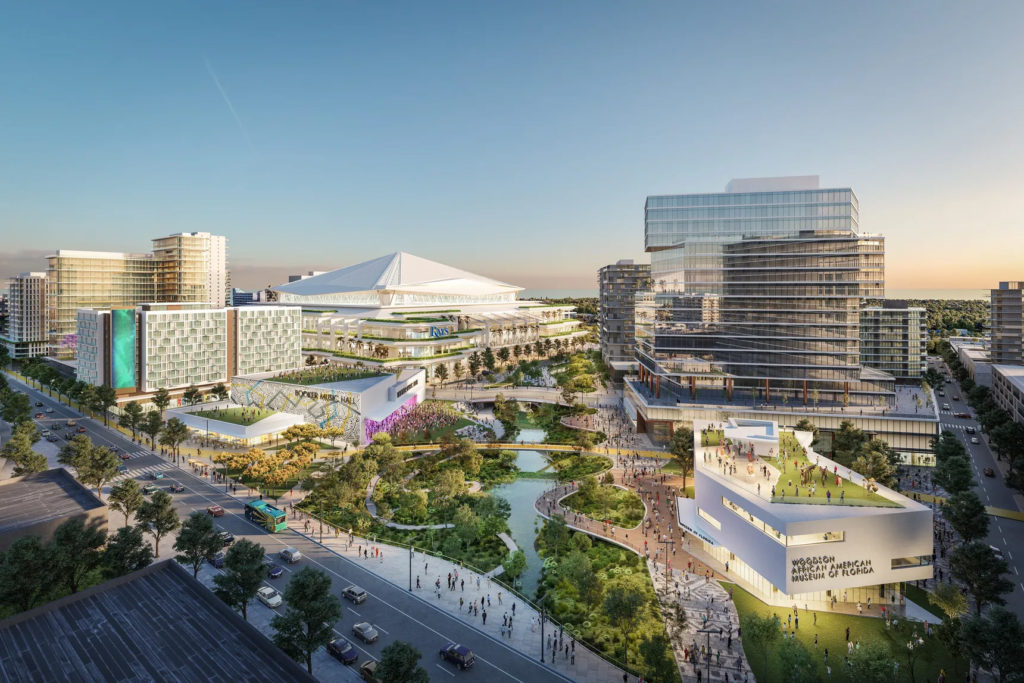
The Tampa Bay Rays and developer Hines announced a deal with the City of St. Petersburg and Pinellas County for a 86-acre redevelopment of the Historic Gas Plant site, complete with a $1.3-billion new Rays ballpark that commits the team to the market for 30 years.
Tropicana Field currently sits at the 86-acre Historic Gas Plant site. Under the agreement, the team will play at the Trop through the 2027 season while a new ballpark and associated development will begin on the other half of the property. The goal is to open the new ballpark for the 2028 season along with 20 percent of the associated development, with a 2024 groundbreaking. The Trop will come down once the new ballpark opens.
Overall, partner Hines is planning to invest more than $6.5 billion in St. Petersburg over 20 years, creating the largest (nearly 8 million square feet) mixed-use development project in Tampa Bay history. The team had been considering two development-oriented ballpark plans, with one location in Tampa’s Ybor City area and the other at the Historic Gas Plant site. St. Petersburg had originally planned on developing the site without the potential of a new ballpark, but soon after taking office, Mayor Ken Welch and staff issued a new RFP on an ambitious Tropicana Field redevelopment over 86 acres, including a potential 17.3-acre new ballpark site for the Tampa Bay Rays.
The development plan unveiled by the Rays and Hines builds on that original proposal with a slightly more ambitious development goal while filling in the details of the overall plan. The agreement increases the number of affordable/workforce housing units to be built by the partnership to 1,200, with at least half of that amount to be built on the Historic Gas Plant site. It also adds onsite affordable units for seniors.
Once fully built, the project is planned to include:
- 14,000 parking spaces
- 4,800 residential units
- 1,200 affordable/workforce residential units (on and off-site)
- 600 senior living units
- 1,400,000 square feet of office, medical and commercial space
- 750,000 square feet of retail
- 750 hotel rooms
- 100,000 square feet of entertainment space, including a concert venue to seat up to 4,000
- 50,000 square feet of civic space, namely a new home for the Carter G. Woodson African American Museum
- 90,000 – 100,000 square feet of conference, ballroom and meeting space
- 14 acres of public open space
The ballpark will have a capacity of around 30,000 for baseball, with the ability to accommodate up to 35,000 for other events. That would put the new ballpark as the smallest in Major League Baseball; currently Progressive Field (Cleveland Guardians) is the smallest facility in the majors with a capacity of 34,830, while several others–loanMart Park (Miami Marlins), Target Field (Minnesota Twins), Fenway Park (Boston Red Sox), Kauffman Stadium (Kansas City Royals) and PNC Park (Pittsburgh Pirates)–feature capacities under 40,000. (The Oakland A’s are also planning a capacity of 30,000 for the team’s proposed Las Vegas ballpark.) The Rays will pay for more than half of the $1.3 billion ballpark and be responsible for any cost overruns. Pinellas County and the City of St. Petersburg will combine to contribute approximately $600 million in equal amounts; those funding details still need to be announced.
The plan needs to be approved by both Pinellas County and the City of St. Petersburg.

One question that’s popped up since the announcement yesterday of a new Rays ballpark in St. Pete: Why the team decided to stick with St. Petersburg and not move forward with a new ballpark in the Ybor City area of Tampa. The answer, from Rays president Brian Auld, is that there’s now a proven track history of large developments economically working with ballparks as a centerpiece; i.e., the Battery in Atlanta. In addition, the last five years have seen changes in the Tampa Bay market, with population growth in downtown St. Petersburg, a marked rise in the attendance for the Rays this season and changes in work habits (more employees working from home means more St. Petersburg and Pinellas County residents avoiding the daily commute to Tampa), per the Tampa Bay Times:
“One of the things I’ve said multiple times is we’re in the same location as we were five years ago, but I really do feel like we’re in a different city,” Auld said.
“There are so many (new condos and apartment buildings) all across the city, and all across this region, that I do believe it has fundamentally changed this region’s, and this city’s, ability to support our team….”
“It’s all kind of starting and building on itself. And that’s enough to give us the confidence to go forward with it … to say, hey, we’re ready to take this risk. And it’s not like a county and city aren’t jumping with us. We’re in it together, our successes will be joined. And it’s exciting.
“But, yeah, I’ll be the first to tell you, even five years ago, it was hard to imagine thinking this was going to be a great idea.”
Rendering courtesy Tampa Bay Rays and Hines.
RELATED STORIES: Rays to unveil new St. Petersburg ballpark plan; Rays’ Sternberg: “Open to selling the team”; Sternberg: Yes, I’m committed to a new Tampa Bay Rays ballpark; In surprise, Tampa Bay Rays attendance up 28 percent this year; Four plans for Tropicana Field redevelopment, including Rays pitch, received by St. Petersburg; St. Pete makes another run at Tropicana Field redevelopment; Tropicana Field site development halted; new bidding to include Rays ballpark; Manfred once again calls for sense of urgency about new Tampa Bay Rays ballpark; Manfred: Rays ballpark search now requires “sense of urgency”; Rays pull plug on joint Tampa/Montreal tenancy after MLB Exec Council decision; Rays envision a pedestrian-friendly Ybor City ballpark; Another Ybor City site considered for new Rays ballpark; Is Tampa ballpark bid gaining momentum?; It’s back: Rays revive Ybor City ballpark plan
